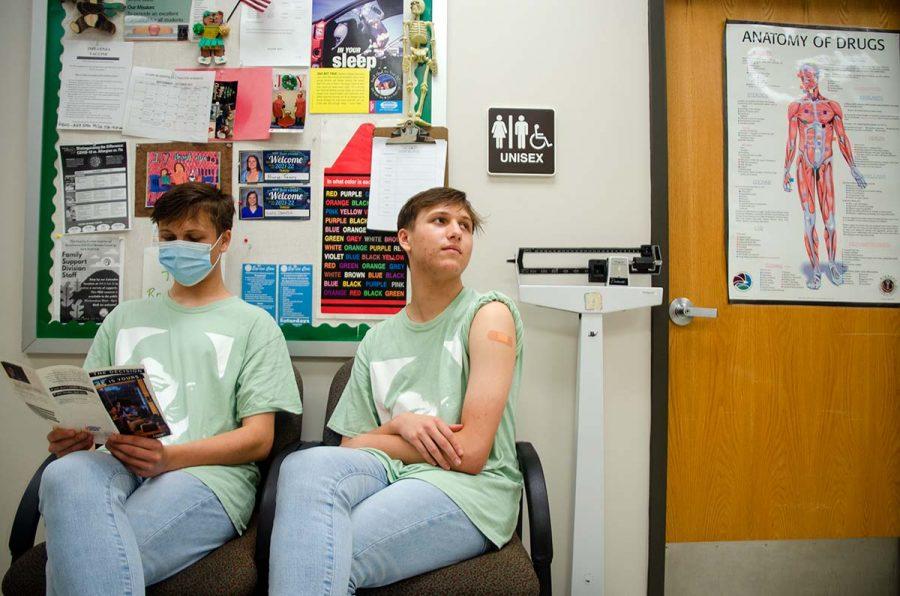The global pandemic continues to play a recurring role in many people’s lives even as things that are thought to be “normal” are reimplemented like in-seat learning and less preventative measures according to “As Life Begins To Return To Normal, Psychologists Say Expect Anxiety” by National Public Radio. Throughout the interview Vaile Wright, senior doctor of health care innovation at the American Psychology Association emphasizes the level of uncertainty in place as the country reopens. The role of the variants and vaccines are “unclear” in regards to the future of the pandemic according to Wright.PDF COVIDPDF COVIDPDF COVID
Sara Humm, Boone County Health Department Public Information Specialist, focuses on reporting health-related issues to the public; her role is especially critical now, in the face of a global pandemic. According to Humm, “there is no certainty for the future of COVID-19,” but there are ways to help prevent the spread of the virus.
“While we can’t tell the future, we can certainly provide suggestions on risk mitigation so people reduce the likelihood that they will get sick with COVID[-19] and spread it to other people,” Humm said. “We can all do our part to keep ourselves, our families, our friends, our neighbors and our community safe. Those things include being vaccinated, wearing a mask when inside public places, avoiding large crowds, washing hands regularly, being tested if symptoms appear and staying home when sick.”
Even though vaccinations are continuously being distributed according to the CDC, it might be a long time before things are back to “normal,” Humm said. Dr. Sara M. Parker, Associate Clinical Professor for Clinical and Diagnostic Sciences and Respiratory Therapy at the University of Missouri—Columbia, said the new variants such as the Alpha, Betta, Gamma and Delta will need time to determine their effects by doctors.
“Each new variant requires study to determine whether they will become a ‘variant of concern’ or not. This takes time and resources,” Dr. Parker said. “Delta is a concern because it is the most transmissible to date.”
The variants are impacting the way society views the danger of COVID-19. Experts saw a steady number of vaccination rates over the summer, according to Humm. Although there wasn’t a drastic number of increased vaccination rates, the consistency is a “good sign” Humm said.
“Because Delta is much more contagious than other variants, it did change the way some folks interacted with each other,” Humm said. “Because the local health orders expired in the spring, things like mask wearing and social distancing weren’t required, but when Delta was detected in early summer, more people started wearing masks again and altering their plans for gatherings to increase the risk mitigation efforts.”
Some educators, like Columbia Area Career Center (CACC) Principles of BioMedical Sciences teacher Christine Roberson, are currently also aware of the uncertainty about the future of the pandemic. Roberson said the COVID-19 pandemic might take a while to overcome because of low vaccination rates.
“The reported infection fatality rate of SARS-CoV-2 [COVID-19] is almost seven times that of flu. The transmission rate is substantially higher. COVID-19 [is] far deadlier and shows some serious long haul damage to some. I hope we get to the point that the frequency of the SARS-CoV-2 [COVID-19] virus is low enough, and the vaccinated population is high enough, that we can deal with small outbreaks like we would with any other serious virus,” Roberson said. “With the current reservoir of vulnerable hosts around the world, and the tendency for RNA viruses to mutate, I think that the future is pretty far off.”
COVID-19 is compared to the 1918 H1N1 influenza A virus pandemic, but unlike the flu, COVID-19 is a new, rapidly changing virus which is affecting the way doctors, scientists and educators like Roberson are studying it. Although the COVID-19 virus and the H1N1 influenza A virus are similar because they are both respiratory viruses, they are significantly different because of the way their numbers are measured, according to Humm.
“There is generally a lot of comparison to the 1918 Flu Pandemic [H1H1 influenza A pandemic]. Just recently, the U.S. death toll from COVID[-19] surpassed the U.S. death toll from the 1918 pandemic. However, there are some things to consider when comparing the numbers,” Humm said. “One of them is that COVID[-19] isn’t over and that the death toll will keep growing. Additionally, the available medical treatment, technology and recordkeeping has changed a lot in more than 100 years so the context should be considered in that comparison.”
Medical professionals are urging citizens to get the COVID-19 vaccine to help reduce the spread of the virus, Dr. Parker said. Despite the unlikeliness of the virus fully disappearing, vaccines and other preventative measures are shown to be effective in slowing the spread of the virus according to Parker.
“Because it is a virus, [fully getting rid of the COVID-19 virus] is unlikely. However, as people’s immune systems evolve over time, the impact of it will be less,” Dr. Parker said. “We can hope for the years when COVID[-19] will cause less severe illness in patients. Vaccination will help.”
According to Humm, the ability to return to “normal” is changing everyday because the future of the pandemic is unpredictable. Several factors like vaccinations and variants are impacting what doctors thought the future would originally look like and what it looks like now, Humm said.
“This idea of ‘normal’ is kind of a myth in some regards. When most people talk about that, they think of people going to large events without masks and people traveling without restrictions. However, a lot has happened in the past almost two years and those events have severely impacted many people and those impacts haven’t been the same for every group,” Humm said. “Things like poverty, access to health care, housing, access to food, mental health etc. all have an impact on a person’s overall health and well being. The Census Bureau has noted that between 2019 and 2020, the median household income decreased and the poverty rate increased in the U.S. Also according to the Census Bureau, Black adults had higher rates of economic and mental hardship compared to white adults during the pandemic.”
Despite the mitigation efforts it might be a long time before things are back to “normal.” Masks and other preventative measures could possibly be in the idea of normal in the future according to Roberson.
“Until we have everyone vaccinated and our infection numbers are low, the masks are going to be recommended by public health officials,” Roberson. “Based on current vaccination rates and compliance with public health measures, that day is a long way off.”
What do you think the future of COVID-19 will be? Let us know in the comments below.






















































































